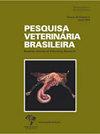巴西Goiás州牛痘病毒的回顾性研究(2010-2018)
IF 0.8
4区 农林科学
Q3 VETERINARY SCIENCES
引用次数: 0
摘要
摘要:对2010 - 2018年巴西Goiás州(GO)牛痘病毒感染情况进行回顾性研究。所有病例都由非洲联盟官方兽医服务处(Agrodefesa)进行了调查,并从中审查了兽医诊断实验室的技术形式和规程。在大多数情况下,通过聚合酶链反应(PCR)和/或病毒分离,提交口腔或皮肤组织和/或拭子样本进行病毒学诊断。在25个县通报了37起水疱病暴发/病例;在33例中,动物表现出与痘病毒临床相容的病变。在33例暴发/病例中,25例的病因经PCR和/或病毒分离证实为痘病毒:13例为牛痘苗病毒(VACV), 6例为假牛痘病毒(PCPV), 5例为牛丘疹性口炎病毒(BPSV)和1例合并感染(VACV和Orf病毒样副痘病毒)。实验室证实,病例主要发生在奶牛(19/25)和旱季(22/25)。在成年牛中,主要在乳头和乳房观察到明显的变化,包括水疱、溃疡、结痂、丘疹和疤痕,并且根据痘病毒种类,其类型、严重程度和受影响区域各不相同。小牛的主要病变是口腔和口部溃疡。在所有诊断的痘病毒中均观察到与痘病毒感染相容的人畜共患病变,特别是影响挤奶工人和其他农场工人的手。我们的数据证明了这些疾病的卫生和经济相关性,以及不同痘病毒在来自GO的牛中广泛传播。本文章由计算机程序翻译,如有差异,请以英文原文为准。
Retrospective study of poxviruses diagnosed in cattle from Goiás State, Brazil (2010-2018)
ABSTRACT: A retrospective study of poxvirus infections diagnosed in cattle from Goiás state (GO), Brazil, from 2010 to 2018, was performed. All cases have been investigated by the GO Official Veterinary Service (Agrodefesa), from which technical forms and protocols of veterinary diagnosis laboratories were reviewed. In most cases, samples of oral or cutaneous tissues and/or swabs were submitted for virological diagnosis by polymerase chain reaction (PCR) and/or virus isolation. Thirty seven outbreaks/cases of vesicular disease were notified in cattle of 25 counties; in 33 cases the animals presented lesions clinically compatible with poxviruses. The etiology of 25 out of 33 outbreaks/cases was confirmed as poxviruses by PCR and/or viral isolation: 13 as bovine vaccinia virus (VACV), six as pseudocowpox virus (PCPV), five as bovine papular stomatitis virus (BPSV) and one coinfection (VACV and an Orf virus-like parapoxvirus). The laboratory confirmed that cases occurred mainly in dairy cattle (19/25) and during the dry season (22/25). In adult cattle, gross changes were observed mainly in the teats and udder and included vesicles, ulcers, crusts, papules and scars and varied of type, severity and affected region, depending on the poxvirus species. In calves, the main lesions were ulcers in the mouth and muzzle. Zoonotic lesions compatible with poxvirus infections were observed for all diagnosed poxviruses, affecting especially the hands of milkers and other farm workers. Our data demonstrate the sanitary and economic relevance of these diseases and the wide circulation of different poxviruses in cattle from GO.
求助全文
通过发布文献求助,成功后即可免费获取论文全文。
去求助
来源期刊

Pesquisa Veterinaria Brasileira
农林科学-兽医学
CiteScore
1.30
自引率
16.70%
发文量
41
审稿时长
9-18 weeks
期刊介绍:
Pesquisa Veterinária Brasileira - Brazilian Journal of Veterinary Research (http://www.pvb.com.br), edited by the Brazilian College of Animal Pathology in partnership with the Brazilian Agricultural Research Organization (Embrapa) and in collaboration with other veterinary scientific associations, publishes original papers on animal diseases and related subjects. Critical review articles should be written in support of original investigation. The editors assume that papers submitted are not being considered for publication in other journals and do not contain material which has already been published. Submitted papers are peer reviewed.
The abbreviated title of Pesquisa Veterinária Brasileira is Pesqui. Vet. Bras.
 求助内容:
求助内容: 应助结果提醒方式:
应助结果提醒方式:


